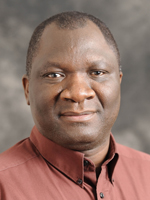 Purdue University - Extension - Forestry and Natural Resources
Purdue University - Extension - Forestry and Natural Resources
Kwamena K Quagrainie

Forestry and Natural Resources
Aquaculture Marketing Director/Clinical Engagement Full Professor
Phone:
765.494.4200
Office:
KRAN Room 626
Address:
403 W. State Street
West Lafayette, IN 47907
West Lafayette, IN 47907
Email:
Why Extension?
Tell us about your background?
Kwamena received his bachelor degree in Agriculture from the University of Science and Technology in Ghana. His master’s and doctoral studies were conducted in Agricultural Economics at the University of Alberta in Edmonton, Canada. Kwamena joined Purdue as an aquaculture economics/marketing specialist in 2005 and has a joint appointment in Forestry and Natural Resources and Agricultural Economics.
How did you come to work on aquaculture? What do people need to know about it?
Kwamena became engaged with aquaculture when he first joined the faculty at the University of Arkansas at Pine Bluff as an Assistant Professor in aquaculture economics and marketing. In Arkansas, he worked with the catfish industry, which is the largest aquaculture industry in the US. He supported the catfish industry with research on marketing strategies for US farm-raised catfish. At that time, the catfish industry faced very strong competition from imported catfish from Southeast Asia, particularly from Vietnam.
How did you get involved with FNR Extension and outreach?
Kwamena’s current extension activities are geared towards assisting fish producers in Illinois and Indiana on economic analysis of their aquaculture enterprise. He works with a team of Purdue Extension staff with interest in aquaculture to develop workshops which has helped the aquaculture industry to reorganize, diversify and consequently experienced some growth. He has developed products and decision support tools needed by potential aquaculture producers to evaluate whether they will enter the industry, to select the proper mix of production systems and species that will be most profitable for them, and to find and develop markets for their products that are secure and profitable. These include spreadsheets, publications and videos. The Purdue aquaculture extension program helps to provide the answers, data, and skills needed by current and aspiring producers in the aquaculture industry. The program also provides technical assistance needed to producers. There has been new startup fish farming businesses in Indiana producing yellow perch, hybrid striped bass, tilapia, marine shrimp and freshwater prawns.
Kwamena’s Sea Grant Aquaculture program focuses on urban aquaculture development in the Chicagoland area with emphasis on aquaponics, an integration of aquaculture and hydroponics as part of the local food production system. Kwamena collaborates with educational institutions in the Chicago area to provide instruction and hands-on training in aquaponics production. This collaboration has involved the University of Chicago, Chicago High School for Agricultural Sciences and the Community Youth Development Institute in Chicago.
Kwamena’s Sea Grant Aquaculture program focuses on urban aquaculture development in the Chicagoland area with emphasis on aquaponics, an integration of aquaculture and hydroponics as part of the local food production system. Kwamena collaborates with educational institutions in the Chicago area to provide instruction and hands-on training in aquaponics production. This collaboration has involved the University of Chicago, Chicago High School for Agricultural Sciences and the Community Youth Development Institute in Chicago.
What do you enjoy most about your work?
Aquaculture provides an alternative agricultural enterprise and opportunities to diversify the agricultural economy. Many existing resources on the farm such as large farm ponds, lakes, and unused buildings can be used for aquaculture to provide additional farm income. Helping farmers tap into such potential is exciting.
What is the biggest challenge you face in your job?
The diversified nature of aquaculture makes it difficult to focus on particular issues or species to work on. The needs of stakeholders and clientele are varied. The aquaculture industry in the region is also small with many small-scale operations producing different species that serve niche markets. Many operations are self-financed and the industry does not attract very large investors and lenders.
What part of your job did you least expect to be doing?
Because of the cold climate in this region, indoor recirculating aquaculture systems (RAS) are commonly used. The controlled system allows the production of virtually any aquatic animal or plant that is permitted by law. Therefore, one always has to keep learning about new things – species, methods, etc because someone will approach you for information on growing a species you’ve not even thought about. Besides the production of traditionally known species like yellow perch, bass, catfish, bluegill, trout, tilapia, etc., some new species currently being grown in the region include marine shrimp, salmon, barramundi (Australian seabass), and Australian red claw crayfish.
Do you have an outside hobby?
Kwamena likes listening to music and watching soccer.
Publications
-
A Guide to Marketing for Small-Scale Aquaculture Producers
-
Economic Importance of the Aquaculture Industry in Indiana
-
Profitability of Hybrid Striped Bass Cage Aquaculture in the Midwest
-
Profitability of Indoor Production of Pacific White Shrimp (Litopenaeus vannamei): A Case Study of the Indiana Industry
Videos
Program Impacts
Awards
-
Purdue University Cooperative Extension Specialists Association: Mid-Career Award - 2012